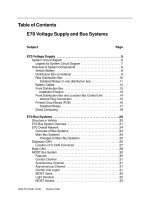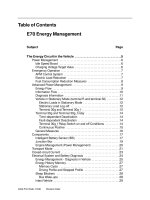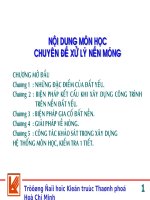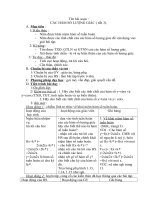C681 03
Bạn đang xem bản rút gọn của tài liệu. Xem và tải ngay bản đầy đủ của tài liệu tại đây (19.78 KB, 2 trang )
Designation: C 681 – 03
Standard Test Method for
Volatility of Oil- and Resin-Based, Knife-Grade, Channel
Glazing Compounds1
This standard is issued under the fixed designation C 681; the number immediately following the designation indicates the year of
original adoption or, in the case of revision, the year of last revision. A number in parentheses indicates the year of last reapproval. A
superscript epsilon (e) indicates an editorial change since the last revision or reapproval.
6. Apparatus
6.1 Cabinet or Room, capable of maintaining a temperature
of 73.4 6 3.6°F (23 6 2°C) at 50 6 5 % relative humidity for
extended periods of time.
6.2 Forced-Draft Oven, capable of maintaining a temperature of 220 6 5°F (104 6 3°C) for extended periods of time.
6.3 Dish, aluminum foil, 2.5 in. (64 mm) in diameter by
0.75 in. (19 mm) deep, with a flat bottom.
6.4 Balance, laboratory analytical type.
6.5 Steel Spatula or Putty Knife, with a blade about 4 in.
(102 mm) long and 0.75 in. (19 mm) wide.
6.6 Desiccator.
1. Scope
1.1 This test method describes the determination of the
volatility of oil- and resin-based, knife-grade, channel glazing
compounds.
1.2 The values stated in inch-pound units are to be regarded
as the standard. The values given in parentheses are for
information only.
1.3 The subcommittee with jurisdiction is not aware of any
similar ISO standard.
1.4 This standard does not purport to address all of the
safety concerns, if any, associated with its use. It is the
responsibility of the user of this standard to establish appropriate safety and health practices and determine the applicability of regulatory limitations prior to use.
7. Procedure
7.1 Condition a sample of channel glazing compound in a
tightly closed container 24 h at 73.4 6 3.6°F (23 6 2°C) prior
to testing. Mix the channel glazing compound thoroughly with
a spatula to ensure uniformity of the sample to be tested.
7.2 Weigh the aluminum foil dish to the nearest 0.01 g and
record the tare weight.
7.3 Transfer approximately 3 to 5 g of the compound into
the tared aluminum foil dish, using the spatula, and spread the
compound uniformly over the bottom of the dish.
7.4 Weigh the dish containing the compound quickly and
accurately to the nearest 0.01 g. Record the combined weight
of the dish and the compound.
7.5 Place the dish containing the compound into an oven
controlled at 220 6 5°F (104 6 3°C) for a period of 3 h, cool
in desiccator at 73.4 6 3.6°F (23 6 2°C) for 1 h, weigh
accurately to the nearest 0.01 g, and record the weight of the
dish plus the sample after heating.
2. Referenced Documents
2.1 ASTM Standards:
C 717 Terminology of Building Seals and Sealants2
3. Terminology
3.1 Definitions—Refer to Terminology C 717 for definitions
of the following terms: glazing, compound.
3.2 Description of Term—Refer to Terminology C 717 for
the description of the following term: channel.
4. Summary of Test Method
4.1 The channel glazing compound is placed into a tared
aluminum dish and weighed. The test specimen is then placed
into an oven for a period of 3 h. After cooling, the test
specimen is reweighed and the percent of volatile matter
calculated.
5. Significance and Use
5.1 This test method provides a guide as to the amount of
volatile matter that will be emitted from a channel glazing
compound when tested by this test method.
8. Calculation
8.1 Calculate the percent of volatile matter, V, in the channel
glazing compound as follows:
V5
1
This test method is under the jurisdiction of ASTM Committee C24 on Building
Seals and Sealants and is the direct responsibility of Subcommittee C24.20 on
General Sealant Standards.
Current edition approved May 10, 2003. Published June 2003. Originally
approved in 1971. Last previous edition approved in 1999 as C 681 – 99.
2
Annual Book of ASTM Standards, Vol 04.07.
A2B
C 3 100
(1)
where:
A = weight of the dish plus the sample, g,
B = weight of the dish plus the sample after heating, g, and
C = sample weight, g.
Copyright © ASTM International, 100 Barr Harbor Drive, PO Box C700, West Conshohocken, PA 19428-2959, United States.
1
C 681 – 03
9. Report
9.1 Report the percent of volatile matter, calculated to the
nearest 0.5 %.
11. Keywords
11.1 channel glazing compound; knife grade; volatility
10. Precision
10.1 The multioperator-day precision for the volatility test
is 60.5 %.
ASTM International takes no position respecting the validity of any patent rights asserted in connection with any item mentioned
in this standard. Users of this standard are expressly advised that determination of the validity of any such patent rights, and the risk
of infringement of such rights, are entirely their own responsibility.
This standard is subject to revision at any time by the responsible technical committee and must be reviewed every five years and
if not revised, either reapproved or withdrawn. Your comments are invited either for revision of this standard or for additional standards
and should be addressed to ASTM International Headquarters. Your comments will receive careful consideration at a meeting of the
responsible technical committee, which you may attend. If you feel that your comments have not received a fair hearing you should
make your views known to the ASTM Committee on Standards, at the address shown below.
This standard is copyrighted by ASTM International, 100 Barr Harbor Drive, PO Box C700, West Conshohocken, PA 19428-2959,
United States. Individual reprints (single or multiple copies) of this standard may be obtained by contacting ASTM at the above
address or at 610-832-9585 (phone), 610-832-9555 (fax), or (e-mail); or through the ASTM website
(www.astm.org).
2





![MAKE magazine [OH] 03](https://media.store123doc.com/images/document/13/ce/fj/medium_fjg1388298702.jpg)



